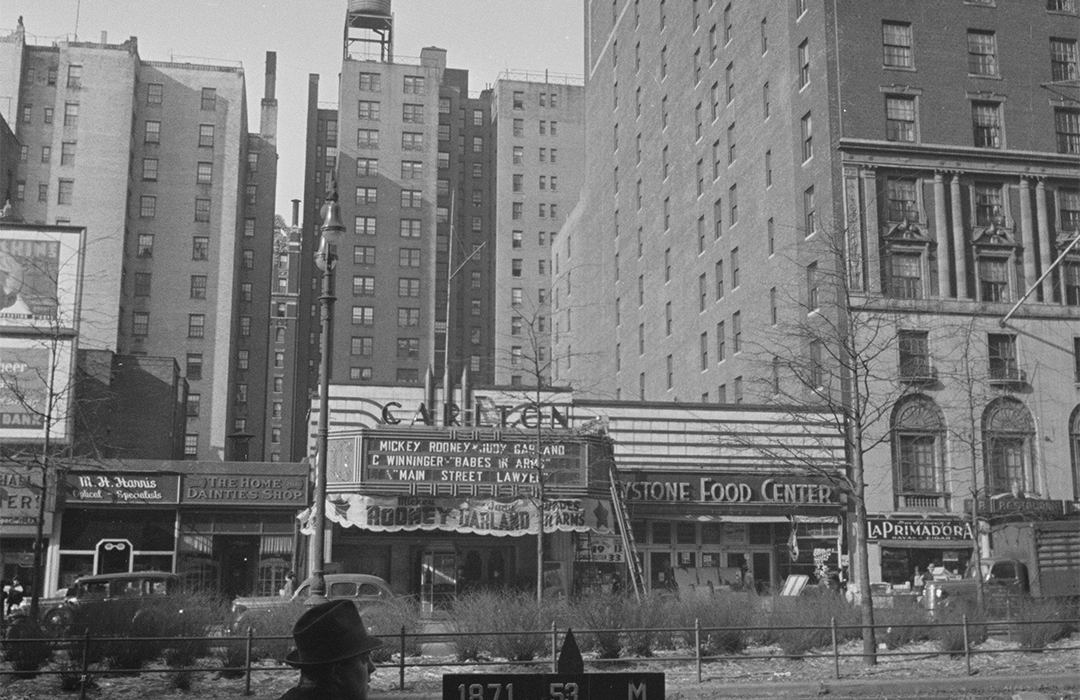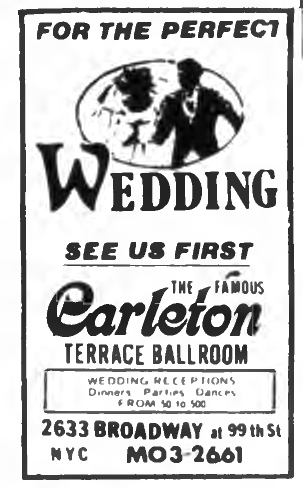
The Carlton Theatre
by Tom Miller
On September 14, 1912, the Record & Guide reported that millionaire real estate developer William Earl Dodge Stokes had leased the plot at 2633 through 2635 Broadway for 21 years to the Quincy Amusement Co. The article noted, “A moving picture and vaudeville theatre will be erected on the property.” The firm contracted architect Henry B. Hertz to design the structure. It would include a commercial space on Broadway.
The one-story Carlton Theatre opened in 1913 and was quickly sold in June 1914 to the Sirrah Amusement Corporation. Apparently not satisfied with Hertz’s design, the new owners brought in architect Walter Katz in October 1914 to make alterations. The remodeled theater was renamed the Riverview.
A second name change came in 1921 when the Keystone Theatre Corp. took over the lease and rechristened it the Keystone Theatre. The store was home to David Fishman’s tailor shop around that time. In October 1926, Fishman hired Tony Spica as a “runner,” or messenger who delivered clothing to customers’ homes. On the 20-year-old’s first day, he was given three suits and six dresses to deliver. The items never made it to their destinations, and Spica disappeared. As it turned out, Fishman was not the young man’s only victim.
“Tony would answer the advertisement of a Broadway firm for an errand boy and vanish when the clothes entrusted to him for delivery made such action worthwhile,” said The Sun
On October 27, The New York Sun reported, “When complaint began to reach the police from Broadway tailors concerning the pilfering activities of an errand boy who carried valuable suits and dresses out for delivery and never returned, Detective Brady of the West 100th street station thought of Tony Spica.” Two years earlier, the teen had been arrested for the same scam. “Tony would answer the advertisement of a Broadway firm for an errand boy and vanish when the clothes entrusted to him for delivery made such action worthwhile,” said The Sun.
Spica was arrested and subsequently identified by six tailors. Also arrested was John Gubas. All of the stolen apparel was found in his tailoring establishment on East 62nd Street. Spica was charged with larceny and Gubas with receiving stolen goods.
The theater was remodeled again in 1933 by architect Raymond Irrern who gave it a sleek Art Deco façade. Vibrantly contrasting stripes of terra cotta tiles emphasized the low building’s horizontal lines, and a new Art Deco marquee was installed. Although the building was still owned by the Keystone Theatre Corp., along with the remodeling, the theater got another name change—back to the Carlton. In 1933 the store was leased to the E. W. Poultry Market, and by 1941 it was home to the grocery store Keystone Food Center.
Marie McCarthy was manning the Carlton Theatre’s cashier’s cage on the night of July 2, 1946, when 18-year-old William Masters thrust a gun through the opening and demanded the money. The Sun reported, “She passed out $367, after which he caught a bus and escaped.” His freedom was short-lived, however. His actions the following day caught the attention of a detective. “After that he went on a spending spree with some friends, and it was his loose handling of his loot that led Detective Cotter to him,” said The Sun. As it turned out, the gun was a fake, made of “wood, wire and wax—painted black with shoe polish.” When asked why he committed the crime, the teen said, “he was weary of working and had found his phony gun so effective that he had started to make another.” The article concluded, “He won’t need it now.”
As it turned out, the gun was a fake, made of “wood, wire and wax—painted black with shoe polish.”
The movie theater closed in 1953, and the space was remodeled into the Carlton Terrace, a restaurant, nightclub, and entertainment venue. Its rentable space was a popular spot for events. On January 29, 1954, the Hyacinths Club held a “formal reception” here. And on May 16, 1959, The New York Age reported on the Drama Guild’s affair to be held on the 22nd. “’Le Petit Paris’…at the Carlton Terrace, 2633 Broadway, will provide a visit to a Parisian nightclub to see the ‘Folies de Fete’ containing such highlights as ‘Can Can’ girls, an Adagio Dance Team, a ‘Bal de Tete,’ and showgirls from the ‘Folies Bergère.’”
The club’s name had slightly changed by April 6, 1963, when Clyde McPhatter, writing in the New York Recorder, said, “If you want an afternoon of good, down-to-earth fun, we suggest that you attend the ‘Sweethearts ‘63’ and Cocktail Dance…at the beautiful Carlton Terrace Ballroom.”
Change came around 1977 when the building was converted to a Gristede’s Mega Store, a neighborhood staple until the structure was demolished in 2005 to make way for a 31-story high-rise.
Tom Miller is a social historian and blogger at daytoninmanhattan.blogspot.com



